[fusion_builder_container hundred_percent=”no” equal_height_columns=”no” menu_anchor=”” hide_on_mobile=”small-visibility,medium-visibility,large-visibility” class=”” id=”” background_color=”” background_image=”” background_position=”center center” background_repeat=”no-repeat” fade=”no” background_parallax=”none” enable_mobile=”no” parallax_speed=”0.3″ video_mp4=”” video_webm=”” video_ogv=”” video_url=”” video_aspect_ratio=”16:9″ video_loop=”yes” video_mute=”yes” video_preview_image=”” border_size=”” border_color=”” border_style=”solid” margin_top=”” margin_bottom=”” padding_top=”” padding_right=”” padding_bottom=”” padding_left=””][fusion_builder_row][fusion_builder_column type=”3_4″ layout=”3_4″ spacing=”” center_content=”no” hover_type=”none” link=”” min_height=”” hide_on_mobile=”small-visibility,medium-visibility,large-visibility” class=”” id=”” background_color=”” background_image=”” background_position=”left top” background_repeat=”no-repeat” border_size=”0″ border_color=”” border_style=”solid” border_position=”all” padding_top=”” padding_right=”” padding_bottom=”” padding_left=”” margin_top=”” margin_bottom=”” animation_type=”” animation_direction=”left” animation_speed=”0.3″ animation_offset=”” last=”no”][fusion_text columns=”” column_min_width=”” column_spacing=”” rule_style=”default” rule_size=”” rule_color=”” hide_on_mobile=”small-visibility,medium-visibility,large-visibility” class=”” id=”” animation_type=”” animation_direction=”left” animation_speed=”0.3″ animation_offset=””]
Jun 25, 2006 – NIWOT, CO –
The following is a Speed Measurement Labs summary on the major test categories as conducted by El Paso Police staff for Speed Measurement Labs. SML defined all the test parameters and the El Paso Police were tasked with running the test and collecting data. Jamie Whisner of Tiger Lily Products also collected data to identify which products performed the best.
Radar Detector: “Instant On” Radar Test Results
To test the “instant on” performance SML placed cones at 2 miles and 1 1/2 miles from the radar guns. Officers in the base van transmitted an instant on radar signal from all three bands for approximately 2 seconds. The recording officer then hailed the test vehicle on the radio to see if the detector had alerted to instant on radar. Each detector was given three tries on each band and all detectors were off except the detector being tested. At the completion of the 2 miles test, test vehicles were moved to the 1 1/2 mile cone and the test was repeated. A total of 117 individual instant on transmissions were made. Y means the detector alerted to instant on radar and correctly identified the band being transmitter. N means the detector did not alert to instant on radar. Rated according to overall performance. To be acceptable a radar detector must alert to instant on radar at 1 1/2 miles. *Cheetah only is programmed to receive K band
**PRS1-V is a full countermeasures system using the Valentine One as a remote (V1 Remote) and Blinder M20 and M40 Laser Jammers. Long Range Radar Detector Testing Results are reported in distance in miles and 10ths of a mile. Reception distance was recorded with the SML staff member holding down the microphone key while in the test vehicle confirming to the base vehicle a consistent radar detector alert with the correct band identified. All detectors were “off” if not being tested. A total of 60 runs were made during the long range test. SML did repeat one run as a passing train emitted a K band signal which is common as they use K band for location and to control crossing signals. Rated according to overall performance. *New Jersey is the only remaining state standardized on X band under state contract. **Note: Whistler Fuzion is a remote radar detector with the antenna mounted in the grill of the vehicle lower than the wind shield mounted competition which accounts for the diminished range compared to Whistler models 325 and 560 with virtually the same reception electronics.
** PRS1-V is a full countermeasures system using the Valentine One as a remote (V1 Remote) and Blinder M20 and M40 Laser Jammers. Over The Hill Radar Detection Test Radar detectors must give drivers warning of radar being used over the next hill. Straight line radar detection is quite simple, but over-the-hill detection can be ticket saving. All test vehicles containing radar detectors were at a cone placed 1/2 mile from the radar gun transmitting van. All three radar bands were transmitted, i.e. X band at 10.525 GHz, K band at 24.150 GHz, and Ka band at 34.7 GHz. Guns were operated in the instant on and constant on modes. Instant on transmissions averaged two seconds while constant on transmissions averaged 10 seconds. After the 1/2 mile location, test vehicles were moved forward to a cone placed at 1,420 feet, slightly more than 1/4 mile. The 1,420 foot location was chosen as any closer than 1,420 feet to the gun would be almost line of sight for the radar detectors. Each detector was given three tries on each band at each location, or thirty-six exposures to all three radar bands. Only the lead vehicle had its detector “on” during the testing. All other detectors were “off.” SML staff and officers swept the course prior to testing to insure no other X, K, or Ka band signals were present. Observers in each vehicle would report to the recording officer in the base van the performance of each detector on each band. The theory of microwave and the rule of least squares would lead one to expect as the distance decreased with the detectors closer at the 1,420 foot cone performance would improve. It did. All detectors have different signal strength reporting visuals to the driver. Some use numbers, while others use strength bars. Allowing for these differences is difficult. Consequently, in reporting the results from 1/2 mile we will list all three reports of each detector. Y means the detectors correctly reported the radar band being used. N means the detector gave no report. Detectors are listed alphabetically. *Cheetah comes from England and is a wireless radar detector similar to a remote with antenna mounted in the grill **PRS1V is a combination unit containing a Valentine One and Laser Blinder from Tiger Lily Products. Note it was mounted higher than other detectors in the pickup pictured above. This extra mounting elevation explains the improved performance of the Valentine One in the PRS1-V configuration compared to the evaluated Valentine One placed in a test car. As expected when the detectors were moved closer to the radar guns at the 1,420 foot cone their performance improved dramatically. However, some were still unable to detect “instant on” transmissions. For this closeness reason detectors were given just one try to properly detect each band. K and Ka POP III Radar (Burst Radar) Detection Test MPH Industries introduced POP mode approximately four years ago. This feature is available on both K band Ka bands from the radar gun maker. It is advertised to defeat radar detectors. In the POP3 mode, the radar transmission is only some 67 milliseconds, or 67 thousandths of a second. The manufacturer says this short transmission is too fast for radar detectors to see. However, the operator’s manual of these radar guns states a POP reading may not be used to issue a speeding ticket as it can not be locked nor can the POP mode be used in the moving mode of the radar gun. In our POP Radar test, test vehicles containing the radar detectors started at a cone placed 1,000 feet from the POP guns and drove at approximately 30 mph. As they approached the 500 foot cone they counted down, “three, two, one” at the cone and the police officer fired the POP mode in the MPH Z-25 K band gun and the MPH Bee III Ka band, 33.8 GHz, radar gun. The officers then asked the observers in each test vehicle if the detector alerted to POP mode or the specific K or Ka bands. Manufacturers were instructed to place their detectors in the POP mode where applicable. To confirm the POP radar guns were working properly, the officers in the base van reported to the test vehicle the speed displayed by the K and Ka band radar guns in the POP mode. In all cases, the K and Ka POP modes showed the speed of the vehicles approaching. Each detector was given three tries against both the K and Ka band POP radar guns. N means the detector did not alert to POP mode. Y means the radar detector alerted to POP mode. A total of 78 runs were made during K and Ka POP testing. In all cases the guns were able to show the speeds of the approaching test vehicles. *Cheetah is a wirelessphoto radar speed trap alert similar to a remote detector only programmed to receive K band **PRS1V/Prowler is a combination unit containing a Valentine One from Tiger Lily Products. Note it was mounted higher than other detectors in the test vehicle pickup POP Radar Testing K and Ka Band At 500 Feet Clearly the claims of the POP gun manufacturer of being invisible or non-detectable by radar detectors is only partially valid. As the results show, the POP mode was successful in only 21 or the 78 tries or 27% of the time.
Radar Detection False Alert History Tiger Lily Products analyzes False Radar Alerts also. We document this performance by measuring the number of alerts, which a radar detector indicates. We test the products which we offer, but have not tested the other products tested by SML above. Laser Detection Testing and Trailing Vehicle First SML wanted to see if the detectors would alert to laser at cones placed at 500 feet and 1000 feet. Officers were instructed to aim first at the windshield where the detectors were located. Next, they aimed their laser guns at the normal aiming point of the front license plate. Remember, at 500 feet the laser beam is small, 18 inches in diameter, 9 inch radius. The beam expands to 36 inches at 1000 feet with a radius of 18 inches. After the results at 500 feet and 1000 feet, we moved the test vehicles to a cone located at 1500 feet and aimed the laser at the target vehicle at the 1000 foot cone to see if the detector at 1500 feet would give any advanced warning to laser being targeted at the vehicle ahead of it. This is called the “Trailing Vehicle Test.” Officers were on the same side of the road as the test vehicles. Y means the detector reported laser. N means the detector did not report laser. Each detector had three tries in each category. We added two laser counter measures to the test category, i.e. Laser Blinder and Lidatek. Both of these systems are stand alone units and not part of an integrated system of radar detection and laser counter measures like Bel, Escort, and K40. Both Laser Blinder and Lidatek claim to render laser guns useless with no speed reading appearing in the laser guns reporting window. Both Laser Blinder and Lidatek’s laser transceivers are located near the license plate and can consist of up to four transceivers depending on the size of the vehicle. Although the SML test shows the Lidatek slightly ahead of the Blinder in this test, it was not noted that the Blinder, which was tested, was an M20, which is a front only laser detector/jammer, while the Lidatek was a front and rear laser jammer. Having said this both the Blinder and Lidatek jammed the laser guns at 1000 feet on the headlights and license plate. But the Blinder jammed the laser guns on the headlights at 500 feet, while Lidatek did not. This is because the Lidatek is a single unit installed at or near the license plate, while the M20 provides 2 laser jammer modules. The results convincingly show when the test vehicles were at 500 feet and the laser was aimed at the front license plate, many had difficulty in reporting the laser. However, at the same distance all reported laser when the laser guns were aimed directly at the detector on the windshield. Save two laser alerts, the detectors did not give any advanced warning to laser’s use when the laser gun was aimed at a vehicle 500 feet in front of it. Radar Detector Detector(RDD) Testing Results are reported in distance at which the RDD detected the radar detector in feet. ND means the radar detector was not detected by the RDD. Three tries each detector. If the radar detector was detected, then the distance it was detected is noted in feet. Where applicable, detector representatives were told to place their radar detectors in the RDD mode. All other radar detectors were “off” if not being tested. A total of 156 runs were made during the RDD test. Performance was concluded by simply adding the total distances of RDD detection. Best performance is zero feet.
The SML data indicates several things that affect the results, so we (Tiger Lily Products) must discuss this. Any radar detector that can be detected by VG2 indicates the radar detector has an 11 GHz IF frequency (older technology). Any radar detector that can be detected by VG2, can also be detected by Spectre II; which searches for both the 11GHz IF and the newer 15GHz IF frequencies. Given the Cheetah reads ND (no detection) on Spectre III and was detected by VG2, then I suspect the Spectre III was not operating properly at this point. The Spectre III has a tendency to overheat. If so, then the Spectre II would normally read 0 (not detected) when hot. If the Spectre II can detect the IF, then the Spectre III can also detect it. For that reason, the Whistler 560 data on the Spectre III is also inconsistent. We find the Spectre III provided less performance this year than last year, however; the data is as noted. Note the Bel, Valentine and PRS1-V were quite good on overall RDD invisibility.
The High Country RDD is a relatively new RDD and has a very small market share due to its limited performance. When it did detect a radar detector, the distance was typically closer than the other three RDD tools. The Bel STi Driver Radar Detector is outstanding in radar detection and providing total invisibility to police RDD.
[/fusion_text][fusion_text]
Call 1st Radar Detectors in Canada at 250-324-8004 or in the USA at 720-635-3931 to discuss your requirements and we will figure out what what you need for your business or your vehicle, and find a US/Canada installer for you. Regards, John Turner
STiR Plus, HP905 Quad Laser Jammer, APC Power Control
STiR Plus, HP905 Quad, HP905 Dual and ProDB-2 Dual PhotoBlocker
Contact 1st radar Detectors at [email protected] to purchase a radar detectors, laser jammer, radar laser jammer; and a photo blocker on passenger cars, pick up trucks, SUVs, and motorcycles in the UK, USA, Australia, Canada, Europe, South America and New Zealand.
[/fusion_text][/fusion_builder_column][fusion_builder_column type=”1_4″ layout=”1_4″ spacing=”” center_content=”no” hover_type=”none” link=”” min_height=”” hide_on_mobile=”small-visibility,medium-visibility,large-visibility” class=”” id=”” background_color=”” background_image=”” background_position=”left top” background_repeat=”no-repeat” border_size=”0″ border_color=”” border_style=”solid” border_position=”all” padding_top=”” padding_right=”” padding_bottom=”” padding_left=”” margin_top=”” margin_bottom=”” animation_type=”” animation_direction=”left” animation_speed=”0.3″ animation_offset=”” last=”no” element_content=””][fusion_text]
| ||
| Jamie, Whisner, SML 2006, El Paso, Texas, June 2006. | ||
| ||
| The M40 Laser Jammer is discreetly installed in the grille of this 2005 Chevy 4×4 pickup. To evaluate a variety of products, we have installed an Escort ZR3 Laser Jammer, RX75 Radar Detector and VF2 Photo Jammer in the front of this vehicle. | ||
| ||
| While traveling across country, we take test the latest products shipped to us to confirm consistent performance through out the year. This is one method we use to measure Performance Ratings and User Friendly operation. We have a Valentine One, Escort Passport 8500 X50 and a Bel STi Driver in the windshield. As we travel down the road, we tabulate the response of each radar detector in real radar and laser encounters to confirm product performance. | ||
| ||
| Radar Detector Detector Invisibility Test. The Bel STi Driver is phenomenal in its invisibility to all forms of RDD, and still offers superb X, K, Ka POP3 radar Detection. The Valentine One, which is incorporated into the PRS1-V Prowler Remote System scored 2nd best for RDD invisibility. | ||
| ||
| 2 Mile Instant On Data and Performance Summary | ||
| ||
| Radar Detection distance Test and Performance Summary | ||
| ||
| Over the Hill Radar Detection Performance and Summary. This data confirms the value of a good radar detector and an average radar detector. If you want to save money and buy a bargain radar detector, it will not detect the hidden “Over the Hill” Radar traps. Why do people think they save money on lower cost radar detectors, when you will get caught by this type of radar trap, and pay even more money to the police??? | ||
| ||
| Pop 3 Radar Detection Data and Performance Summary | ||
| ||
| Laser Detection Distance performance. Our experience tells us that most police aim their laser guns at the license plate or headlights, not in the windshield, where most radar detectors are located. | ||
| ||
| Radar Detection Falsing History. The Escort Passport 8500 X50 clearly has the fewest false alerts, while the Bel RX65 has more false alerts. The Valentine One and STi Driver are very good at providing less false alerts. These 4 radar detectors are the very best in the world for radar detection. |
[/fusion_text][/fusion_builder_column][/fusion_builder_row][/fusion_builder_container]

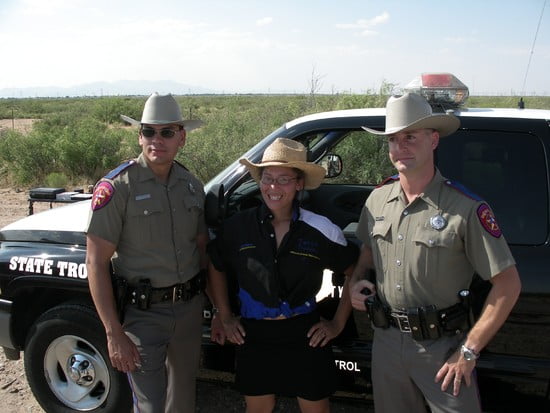
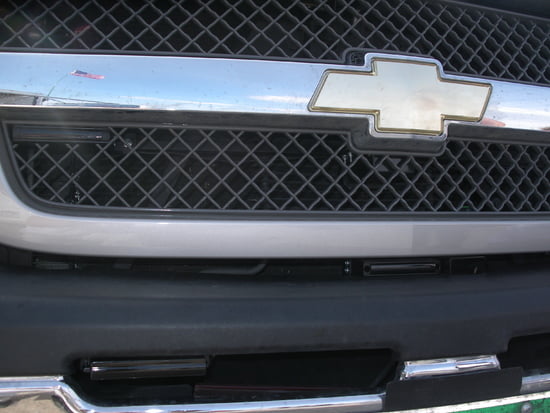
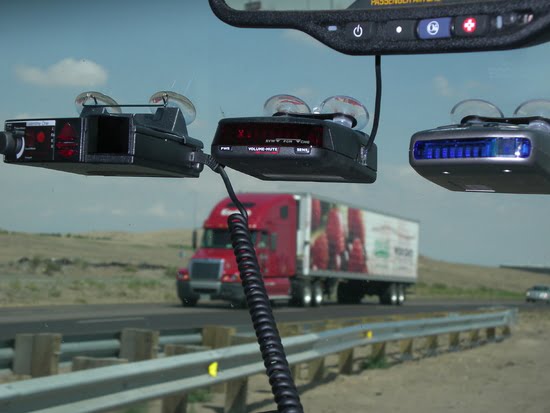
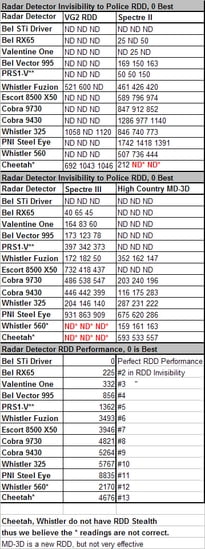
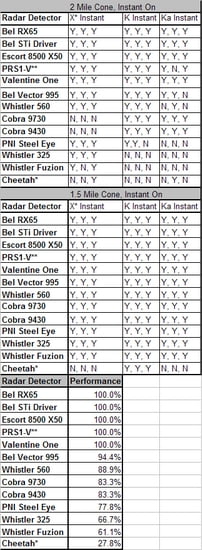
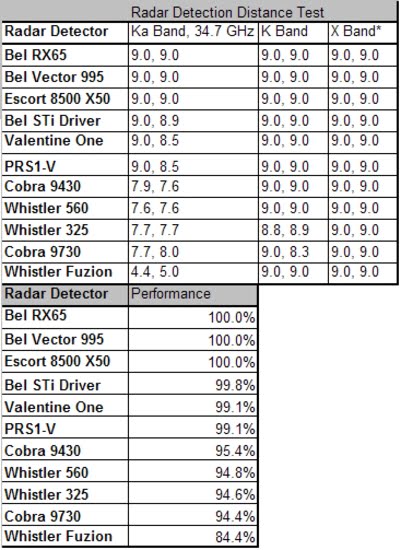
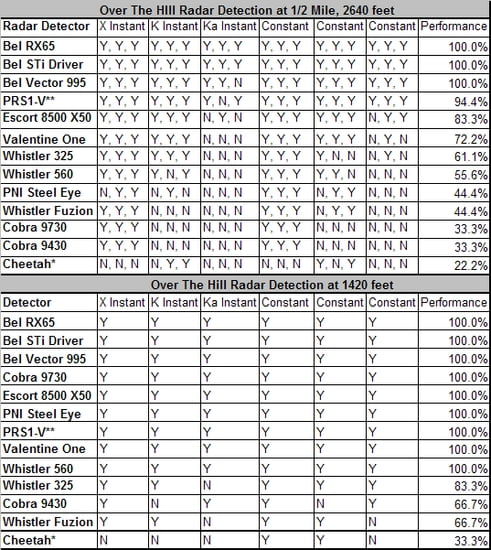
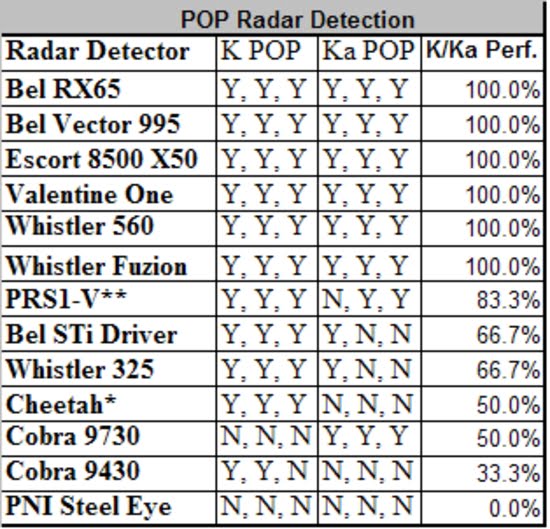
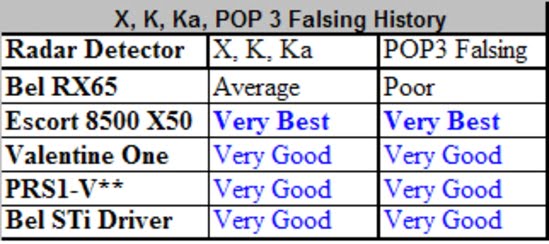
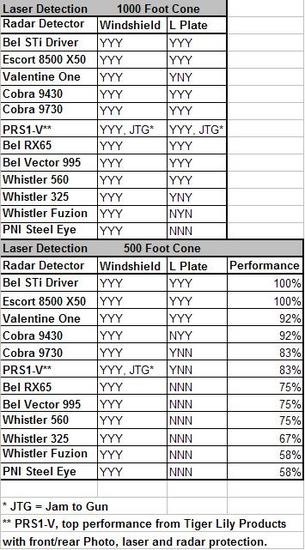
Recent Comments